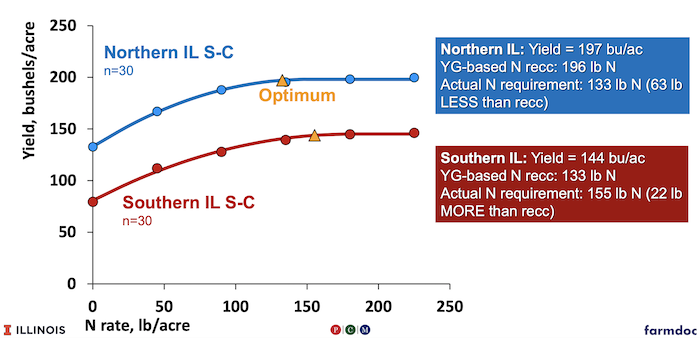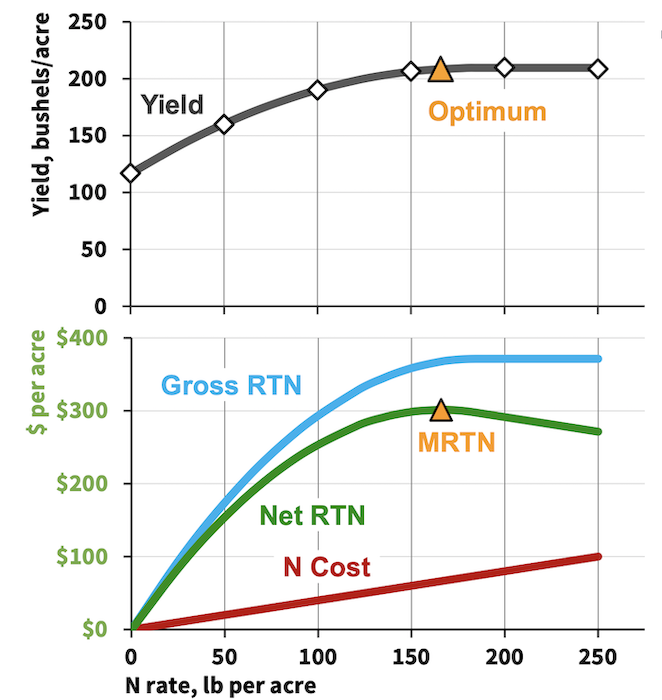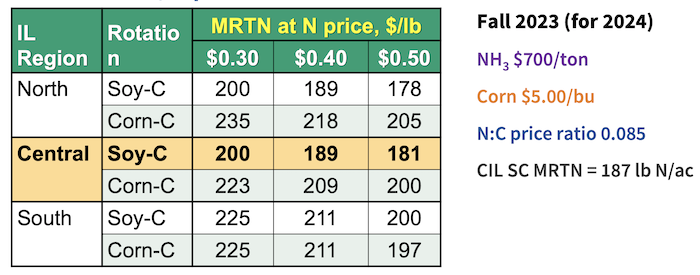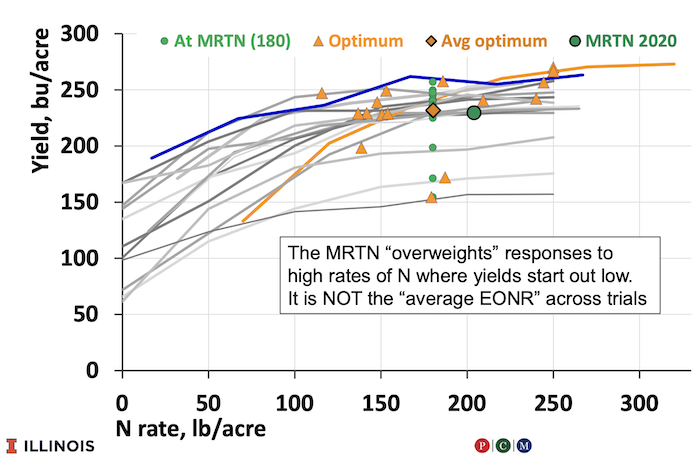“The fertilizer question is alive and well,” says Dr. Emerson Nafziger, professor emeritus at the University of Illinois Urbana-Champaign, in a farmdoc webinar hosted by the Illinois Corn Growers Assoc. As a specialist in crop and soil management, he, like many farmers today, has struggled to pinpoint the most economical amount of nitrogen (N) fertilizer needed for any particular crop.
“About 20 years ago, several of us met together in the Midwest and talked about the fact that we had data for N responses,” Nafziger says, “but we were wondering what we could do with it to make N recommendations come alive.”
From this question and years of data collection, Nafziger developed the MRTN, or Maximum Return to Nitrogen, which he stresses is not just an economic tool but also an agronomic one.
The MRTN is essentially a calculator in which farmers can enter expected corn prices and expected cost of N to receive data on the most profitable application of N per acre. Nafziger stresses these are guidelines, rather than recommendations.
Initial Conclusions
Data was accumulated from 7 sites in northern, central and southern Illinois on corn-on-corn acres and corn-soybean rotations over the course of 10 years.
“Part of our early observation was that the yield goal-based system that we had in place since the 1970s was starting to fall apart, and it was falling apart primarily because yield levels and the need for N were not very closely associated,” Nafziger says.
The goal-based guideline purported that expected yield could be multiplied by 1.2 to calculate the crop’s N needs, and if corn followed soybeans, then 40 pounds of N could be subtracted from the final calculation. However, when the data was plotted, Nafziger found that the yield and pounds per acre of N that it took to achieve that yield were not linear.
“And you can see kind of an astonishing fact, and that is that the higher the yield goes, you don’t necessarily need more N,” Nafziger says, showing that yield increases only up until a certain point, and then it levels off.
The maximum yield, or as he calls it the optimum point, that farmers want to achieve is when the N used is completely paid for by the yield it generates. After this point, additional N use becomes unprofitable.

The optimum point in balancing N costs with net yield is illustrated by a yellow triangle. After 133 pounds of N per acre for northern Illinois and 155 pounds of N per acre for southern Illinois, additional N does not lead to a higher yield.
As illustrated by this chart, when using the longstanding recommendation of yield multiplied by 1.2, a farmer would have been using 240 pounds per acre of N for an expected yield of 200 bushels per acre, when they only need about 140 pounds per acre of N.
While this may not seem like enough N, Nafziger hypothesizes that modern corn hybrids uptake nutrients — and N that is preexisting in the soil — more efficiently.
“We have to understand soil as a primary source of N,” he says. “There is a lot of N in prairie soil that is 3.5% organic matter and 1 foot deep. Based on our rule of thumb, expect that a prairie soil is going to produce 100 pounds of N for the crop.”
However, predicting the amount of fertilizer N that is taken up by the crop is not an exact science.
In practice, Nafziger found that anywhere from less than 5% to greater than 90% of N was actually coming from the soil. It averages out to about 50%, but Nafziger says it is nearly impossible to determine how much of a soil’s natural N vs. fertilizer N a crop is going to use.
“You say, well surely we must be smart enough to figure out how much N that soil is going to give up in a given year. We don’t know how to guess that,” he says. “You can bring soil into the laboratory, and you can measure how much inorganic N it’s producing as it sits there on the bench, and every week take a sample and see how much more N there is than last week. You can do that. It doesn’t in any way, shape or form mimic what’s going to happen out in a field.”
This unpredictability is dependent on many uncontrollable factors, such as soil temperature and moisture, and is something scientists have been trying to guess at for decades, according to Nafziger.
“We tend not to call MRTN calculations recommendations as much as guidelines,” he says, “because a recommendation says there’s more surety about this whole thing than we actually have.”
MRTN Calculations
The MRTN calculation takes into account the cost of N per acre and the gross return to nitrogen (RTN), with RTN being the dollar yield per acre. While N cost increases linearly per acre, gross RTN increases and then levels off in the same way that the crop yield eventually levels off.

In this example, the top graph demonstrates how yield eventually levels off despite additional N application. In the bottom graph, the gross profit from yield does the same while N cost increases linearly. Net RTN illustrates how this leads to diminishing returns after the MRTN point (triangle). This MRTN point was calculated with the price of N being $0.50 per pound and corn at $5 per bushel.
As seen in this chart, the net RTN factors in N cost and gross RTN. Nafziger says crop yields increase up to a certain N rate, and after that, they are no longer affected by additional N application and do not generate proportionate yield. After that threshold, applying more N is an unnecessary cost and takes away from net profits.
MRTN calculations are made with the current N cost per pound and the current cost of corn per bushel. For this chart, the cost of N was $0.50 per pound, and the cost of corn was $5 per bushel. The MRTN for this graph was reached at 160-165 lb of N per acre at about $300 net profit per acre.
If the price of N and/or corn were to change, the range of profitability and MRTN — and therefore the shape of the graph — would change with it.
According to Nafziger, lower corn and higher N prices would move the curve of the graph to the left, meaning a lower MRTN, and the opposite would move the curve to the right, meaning a higher MRTN.
Nafziger added a range of about 15 pounds of N in either direction to help farmers assess their predicted profit. The curve is relatively flat at the top, and within that 30-pound range, farmers can more easily say that their predicted profit is going to be close to that optimum point.

Using the MRTN calculation, Nafziger outlines several possible optimum N application rates based on the prices of N and corn.
Data Driven
“A poor database makes a poor recommendation,” Nafziger says, noting that the MRTN is only as good as its data.
More data points are better, but there is no way to know how many are sufficient for the most accurate prediction. And as with any collection of data, there will be outliers. Things such as unusual weather conditions, waterlogging and other root issues can produce unusual responses.
“Responses are not predictable, and we either use results we built up over a lot of trials, or we just make it up,” he says. “Back when N was a few cents a pound in the 1960s, the recommendation was just use plenty, and that was absolutely what people did.”
While there is still an element of unpredictability, farmers don’t have to throw N at crops with as much uncertainty with MRTN.
How Accurate is MRTN?
Because trials are ongoing, data is being added each year to further improve the accuracy of the MRTN calculations.

Nafziger explainst that the MRTN overestimates N requirements based on current market prices. According to data from 2020, the actual N requirements were about 25 pounds per acre less than expected.
What Nafziger found is that the MRTN ends up being more conservative than the actual N requirements of a crop. According to 16 soybean-corn trials in 2020, the actual MRTN (diamond) fell to the left of the predicted MRTN (circle), meaning the actual N requirement was about 25 pounds per acre less than anticipated.
However, it’s important to note that these trials are specific to the environmental conditions in their regions.
“Data from sites with similar soils, texture, depth, topography and drainage will produce a better prediction for that soil,” Nafziger says.
This is why Nafziger specifies whether his trial sites are in northern, central or southern Illinois. It’s also why the calculator asks farmers to specify their state and applicable soil type in order to give them the most accurate prediction.
Predicting fertilizer needs and actual N uptake by crops can feel like guesswork, especially when trying to balance cost with net profit. However, when Nafziger’s data is accumulated and plotted, patterns start to emerge, which help farmers balance profit with optimum crop health.
“The MRTN maximizes the return to N at a certain ratio of N to corn prices,” he says. “The higher that ratio is, the more N costs relative to the corn, and the less N we can put on and still have that corn crop pay for it.”
Related Content
Preplanting Nitrogen? Here’s What You Need to Know
Proper Fertilizer Timing & Placement Optimizes Nutrient Needs







Post a comment
Report Abusive Comment